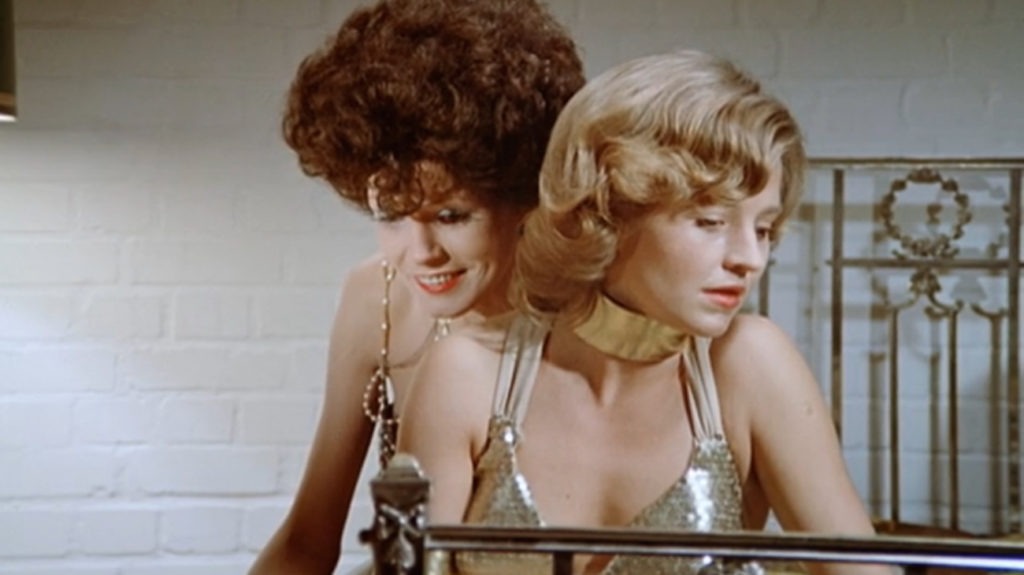Fassbinder adapted the film from his own play, and he put no effort whatsoever into opening it up. The whole film, practically, takes place inside one apartment – inside one room of one apartment, there are a grand total of six characters (all women), and it takes place in four clearly-defined acts. Even so, the film is utterly cinematic, as Fassbinder and his cinematographer, the singularly great Michael Ballhaus, find every possible corner in which to situate their camera, bending in to look at the action from stuffy, intimate angles, often using camera movements that march sturdily from one mark to the next with the chilly, formal precision of a court dance. It is among the best-shot single location films that I have seen, not just because of the stylistic variety that Fassbinder and Ballhaus are able to bring into play, but for how much the image never feel stylish for their own sake, but always serve as the visual expression of the psychological gamesmanship between the characters.
Petra von Kant (Margit Carstensen) is a major fashion designer working out of Bremen, Germany; the film consists of extended vignettes in which she exerts herself passive-aggressively on a handful of other women in a series of emotionally sadomasochistic relationships, erotic and otherwise. Her targets include her long-suffering assistant (an especially apt use of a stock phrase, in this case) Marlene (Irm Hermann) and the beautiful young Karin (Hanna Schygulla), with the final scene shifting focus more to Petra’s family relationships, and how she’s even worse at those than her sexual relationships.
It’s no more fun than it sounds, but the filmmaking is so vibrantly alive, and the performances so uniformly enthralling, that it’s still a scintillating, gripping viewing experience. Carstensen in particular is beyond great, in her screen acting debut: she plays Petra as a mixture of sharklike predator, resentful victim, and theatrical object, creating an aura around her character that locks out the rest of the cast while pulling the film viewer right up close to her. She is pitiable and reprehensible throughout the film, with Carstensen’s outsized performance working alongside the costumes and wigs she’s given to suggest a constant state of fluctuation and re-invention, untethered identities constantly swirling around a core that Petra protects at all costs.
With that in mind, I had some ground rules for my shot: Carstensen had to be in it. Period. That’s not tough (she’s in most of the shots), though it did knock out of contention one profoundly striking image from near the end. Some other requirements: that it foreground the way she poses and performs in her attempts to relate to other characters; that it stress the vaguely surreal nature of Petra’s apartment, a fussily-appointed but weirdly sanitary space that has a nightmare’s slippery relationship to realism. Here’s what I came up with:
It doesn’t feel entirely like a real space – it’s more of a conception of a bedroom than an actual bedroom, especially with the painted brick. But obvious, I didn’t choose this because of the production design. It’s the poses, more than anything, that sealed this as my pick for the film’s best shot: the way Schygulla shrinks in to diminish herself, while Carstensen looms up behind her, looking like some kind of hideous growth sprouting from her shoulder, or a vampire about to strike. And in this particular frame, she’s got that toothy smile, too: a little too hungry and alert to be friendly in the way she’s probably aiming for. The dynamic of this moment is complex as all hell: Karin has been telling a story about her sorrowful life, play-acting the part of the innocent to attract Petra; Petra assures her that together, there will be no more suffering between them, but she says it with more frenzy and desire in her voice than comfort or love. It is, in short, two people lying to each other about their emotional bond, and the uncomfortably, lurching poses embody those lies.
There’s other stuff going on that’s worth pointing out: how low they are in the frame, for one thing. The white wall is dominating them, and we see just enough of the bed frame for it imply the bars of a prison. I would also like to call your attention to Petra’s giant fake hair, a huge anchor of brown, and the darkest thing anywhere near the focal points of interest – it’s probably the single part of the composition that most emphasises how much more dominant Petra is in this moment and this space than Karin is. Also of note: the middle of the frame is almost perfectly in between their heads. The combined shape of their bodies is perfectly in the center of the image, but neither of them, individually, is. The composition that results is both flat (centered compositions are almost always static) and dynamic (the offset faces tends to make us flicker our eyes back and forth), so we can never quite be comfortable, any more than the characters are in their own skin.
I mentioned a “profoundly striking image”; I couldn’t live with myself if I didn’t share it with you, my Runner-Up Best Shot from The Bitter Tears of Petra von Kant, in which fake bodies have fake sex under the gaze of a fake voyeur. And there we are, leering in through a window at all of it.
